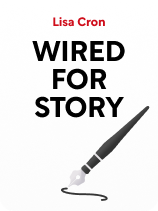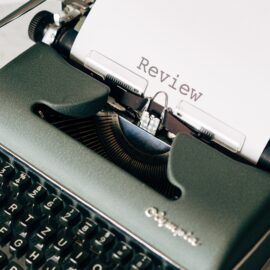

This article is an excerpt from the Shortform book guide to "Wired for Story" by Lisa Cron. Shortform has the world's best summaries and analyses of books you should be reading.
Like this article? Sign up for a free trial here.
Why is it hard to explain what makes a story good? How does that impact our ability to write good stories? What can we do to overcome that difficulty and craft interesting narratives?
In Wired for Story, Lisa Cron argues that our brains evolved to absorb information through stories. So, writers who want to create compelling narratives should write in a way that satisfies our brains’ expectations of story.
Continue reading for an overview of this book that takes a fresh approach to story writing.
Overview of Wired for Story by Lisa Cron
Stories developed hundreds of thousands of years ago as a way to keep us safe from potential dangers without us actually experiencing them. And, thus, we’ve evolved to crave them. Today we continue to use stories to experience simulated realities to learn about life. In Wired for Story, Lisa Cron shares advice that’s directed mainly at literary novel writing, but her principles can be applied to any type of storytelling.
Cron is an experienced writer who spent 10 years working in publishing and then began working as a supervising producer for networks like Showtime and Court TV. She’s also been a story consultant for companies like Warner Bros. and the Buchwald Agency. Her career then led her to be a literary agent at the Angela Rinaldi Literary Agency, and she’s currently an instructor at the UCLA Extension Writers’ Program.
We’ll explore the formula that the human brain has developed to expect in a story as well as how you as a writer can employ that formula. We’ll look closely at how to use your protagonist to engage your reader, techniques for creating conflict and advancing plot, and how to create causal links that appeal to the brain’s need for cause-and-effect structure.
How Stories Appeal to Our Brains
From a neurological perspective, storytelling developed to help us remember important information and use that information to make predictions. Cron says this allowed us to survive difficult challenges by preparing for them without having to experience the dangerous situations firsthand. For example, an ancient hunter-gatherer who had a close call with a bear might regale their community with that harrowing tale, giving them important survival knowledge, like where they might expect to encounter bears and tips for how to get away unscathed (don’t run from it, and don’t try hiding in a tree either!).
In order for us to pay attention to these stories, they had to be presented in a way that appealed to how our brains process information. This caused us to develop expectations for what a story should be like, and if a story doesn’t meet these expectations consistently, we won’t keep listening—or reading. Cron explains that, because these expectations are so hardwired, they’re instinctive. So, we’re not able to easily explain what makes a good story, which is what makes writing one so difficult.
The Elements of a Story
According to Cron, the basic elements of a story that make it engaging are the protagonist, the protagonist’s goal, the plot, and what the story’s truly about (the underlying lesson). These are the things that our brains crave to envision what’s going to happen next, and this anticipation is at the heart of our evolutionary need for story.
The protagonist is the character whose shoes we’re stepping into. They provide us with our point of view for the rest of the story, and they’re the lens through which we’ll interpret everything that happens. The protagonist’s goal is the overarching objective or aim of the protagonist. This is what drives the story internally. It’s how we know what’s at stake for the protagonist, and we gauge everything that happens (the plot) based on the protagonist’s goal.
The plot refers to the actual events that occur in the story. This is often mistaken for what the story’s about, but what the story’s truly about is how the protagonist changes as a result of the story’s events. Plot is the external events of the narrative, while the story is about the protagonist’s internal reactions.
These elements demonstrate that stories are about how we, rather than the world around us, change.
Use Only Important Details
Cron emphasizes the need for efficiency in your story. You should include only information about the above four elements that the reader needs to understand the story. Neurologically, the brain can process around five to seven pieces of information at a time—but it receives over 11 million per second. That means we filter out information that’s irrelevant to us and our goals, and we subconsciously expect stories to do the same. When readers have to sift through information that’s irrelevant to these parameters, they lose track of what’s supposed to be holding their attention, and thus they lose interest.
In addition, the brain processes information through concrete details. Cognitively, it’s difficult for us to understand abstract concepts or generalities, so when writing a story, it’s essential to use details for everything. While excessive, unnecessary details will derail a story and distract the reader, describing things generally or abstractly will confuse the reader and keep them from understanding the point.
How to Build Your Protagonist
According to Cron, the protagonist is what helps you as a writer determine what information is important and what isn’t. The protagonist is who the story is about, and it’s the character your reader will need to relate to in order to feel engaged in the story and understand the importance of everything that happens.
The Importance of Emotion
The way the reader relates to the protagonist and understands the importance of the story’s events is through emotion. Therefore we must convey information about the protagonist through their emotional state. Indeed, the importance of every detail in your story is determined by its emotional impact on the protagonist.
Emotion is what helps us determine what information is important and what isn’t. To illustrate this neurological phenomenon, Cron shares the story of a man who suffered brain damage that took away his ability to feel emotion. Though the incident had no impact on his intelligence, memory, or problem-solving skills, he was unable to continue in his successful career because he could no longer make decisions, even minor ones. His neurologist concluded that without emotion, every option in every choice seemed neutral—and thus, was equally important and impossible to decide upon.
How to Convey Your Protagonist’s Emotions
In the same way that having no emotion keeps someone from assessing the importance of a piece of information, if the reader doesn’t understand the emotional impact a detail has on your protagonist, the detail will seem unimportant, and the reader won’t be interested in it. In this regard, says Cron, prose writing offers a narrative tool not available in other types of storytelling like screenwriting or playwriting: the ability to see into another person’s mind and directly understand their internal thought processes—how a piece of information is affecting them, for instance. While media like films and plays leave the viewer to intuit the characters’ emotions and thoughts, prose can convey them explicitly.
In prose, explains Cron, there are three main ways you can convey your protagonist’s emotions (and thus the importance of any external event) to the reader:
1) You can demonstrate them through your protagonist’s external actions. For example, “Molly’s son Brian was late getting home, again. She sat at her desk, tapping her pen rapidly and staring at the door, her jaw tight.” Molly’s external behavior conveys anger and frustration.
2) You can give the reader the information to intuit your protagonist’s emotions. For example, you can tell the reader that Molly needs help with the housework and was looking forward to having Brian help her so she could take a break. The reader can then intuit that her son’s late arrival will make her angry.
3) You can show them directly through your protagonist’s thoughts. “Molly grew more and more frustrated as the minutes ticked by. She rehearsed the tirade she’d give Brian when he finally walked in the door, but she knew deep down it wouldn’t make a difference. There was nothing she could say that she hadn’t said already.”
Identify the Internal and External Goals
According to Cron, the emotional impact that something has on your protagonist is specifically determined by how it impacts their goal. Neurologically, all our behavior is driven by goals, and we’re programmed to try to figure out other people’s goals so we can pursue our own more easily. Your protagonist’s goal is what gives meaning to everything in your story.
Your protagonist may have many goals, but there is one underlying goal that drives everything they do, which Cron refers to as the internal goal. This is the internal issue that makes it hard for the protagonist to achieve their other goals, which Cron refers to as external goals.
For example, a superhero might have an external goal of saving the world from a villain, but her internal goal might be to act in a principled way through the process. The external goal makes it hard to achieve her internal goal, but ultimately she manages to achieve them both by refusing to act cruelly even while fighting the villain.
Identify the Mistaken Belief
To start your protagonist on their journey, you need to pinpoint the moment when a central view they held about the world was challenged or altered. Cron explains that, according to neuroscientific research, our understanding of the world isn’t representative of how the world is, but of how we believe it is. To develop a strong internal goal, something must happen to your protagonist that contradicts a belief they hold about the world, and this opposition must create a conflict in the protagonist that interferes with what they want to achieve. This resulting struggle will lead to your protagonist’s change or growth as a human.
While this worldview-changing moment kicks off your protagonist’s development, it doesn’t need to happen at the beginning of the story. In fact, you might not describe this event in your story at all: You might simply hint at it and show its impact through the actions and decisions your protagonist makes. But you as the writer must know what it is before you begin writing. You may find it useful to create a character bio to help you identify this moment.
For example, if your protagonist believes that those who work hard are justly rewarded, her worldview-changing moment might be when she’s passed up for a promotion in favor of a well-connected but lazy coworker. This would spark an inner conflict that could fuel her internal goal over the rest of the story—whether that be to win back the promotion or to get revenge.
Put Your Protagonist Through Hardships
Cron also explains that, since our brains use stories to help us imagine future hardships and difficulties that could interfere with our goals, you shouldn’t coddle your protagonist by keeping them out of trouble or protecting them from the plot. Instead, you should put them into situations that seem impossible to overcome—but aren’t—and show the reader the protagonist’s grueling, painful journey to achieving their internal goal. According to Cron, great stories are about how people change, and change is painful. This means your protagonist will suffer, and because we relate so closely to our characters, Cron says this is often a difficult thing for writers to do, but it’s also what makes a great story.
How to Build Your Plot
We’ve discussed the first element of story, the protagonist. Now, we’ll discuss the next element: plot, or, the story events themselves. Plot consists of the many conflicts that create obstacles to your protagonist achieving their goal. To subject your protagonist to these seemingly impossible obstacles, you have to establish and escalate conflict in your story.
Conflict
As mentioned above, stories are about change, and conflict is what drives change. According to Cron, our brains are programmed to resist conflict. We evolved to cooperate for survival, so conflict with others poses a risk to our survival—and in fact, according to an MRI study, conflict causes the brain areas associated with physical pain to light up.
Our brains also resist change, whether it’s a good or bad change. We evolved to seek to maintain a state of secure equilibrium to ensure our well-being—if we’ve found a routine that keeps us safe, making a change to that routine creates a potential risk to our safety, which makes us fearful.
However, because things constantly change in life despite our wish for them not to, stories must also be about conflict and change. Cron writes that there are many potential sources of conflict in a story: Any way you can find to pit two forces against each other in a way that impacts the protagonist emotionally and interferes with their goal is a potential conflict and impetus for change. Some of these include the conflict between the protagonist’s belief and reality, the conflict between what the protagonist wants and what others expect of them, the conflict between the protagonist’s internal and external goals, and the classic conflict between the protagonist and the antagonist.
Cause and Effect
Showing how conflict leads to change also requires us as writers to convey a clear pattern of cause and effect. According to Cron, we have a neurological need to understand the reasons behind everything, which means our stories need to have a clear cause-and-effect structure on both the external plot level and the internal level of the protagonist’s choices. Things can’t just happen at random—rather, every action must have a reaction which then affects the next decisions the characters make. This establishes the logic of your story, which the brain needs to maintain interest.
Cron points out that the maxim “Show, don’t tell” is commonly misunderstood to mean that we should avoid explicitly stating something—like the emotion a character’s feeling—and instead show them feeling it, by expressing it physically (through crying, yelling, smiling, and so on). However, she argues that what it really means is we need to show the cause-and-effect process that leads to that feeling. It’s not enough to say your character is angry. Rather, we need to see the event that made them angry, and we need to understand the internal thought process that caused them to react the way they did to the story’s events.
According to Cron, this cause-and-effect structure must be consistent throughout your story, which means that each scene will logically lead into the next one. The previous scene will catalyze the next scene, and the effects of the characters’ choices in the previous scene will determine the choices they make in the next scene. This also means your protagonist needs to change from scene to scene. They should feel differently at the end of the scene than they did at the beginning. By connecting all the scenes in your story in this way, you’ll create a cohesive, logical narrative that helps the reader understand the reason behind everything and satisfies their neurological need to simulate an experience they’ve never had.
How to Hook the Reader
As soon as the reader begins your story, they start looking for the answers to three major questions: 1) Who’s the story about? 2) What’s the story about? 3) What’s at stake here? If the answer to any of these three questions is missing, it doesn’t matter how beautiful your prose is; the reader will not be interested in your story. However, says Cron, if you answer them quickly—on the first page, or even in the very first sentence—you can take your time presenting the rest of the details because your reader knows what to anticipate.
The answers to these questions give the reader context for how to understand everything they’re about to read, which, according to neuroscientific research, is how they determine meaning, or the “why” behind every piece of information. Answering these “why” questions is critical to do because humans have a natural curiosity about why any given piece of information is significant or useful to us, and having that curiosity sated is what keeps us engaged with what we’re reading.
For instance, we don’t just want to know that the protagonist is getting a divorce; we want to know the specific reasons why they’re getting a divorce so we can understand how the divorce will impact the protagonist and how it might affect what they’re going to do next.
Suspense and Reveals
According to Cron, the push and pull between two conflicting forces allows the writer to build suspense by withholding information that the reader wants to know. Suspense is what keeps the reader turning the page because of our cognitive need to know what happens next.
While the big “reveal” of withheld information can be extremely powerful, it only works if everything up until that reveal is clear and logical enough for the reader to understand. The writer must give hints about the reveal in advance, so the reader has a sense that something is missing, but the absence of that missing piece can’t obscure the story.
These hints must also be specific enough that the reader can guess what the reveal might be, even if their guesses prove to be completely wrong. It’s not interesting enough to know that the writer is keeping something secret. We have to have some sense of what they’re keeping secret.
For instance, a mystery writer might plant hints throughout the plot that point to the identity of the murderer. The reader will know the writer is keeping the murderer’s identity a secret to be revealed later. Even if they incorrectly guess who it is, they’ll still be able to understand the logical sequence of events that led the person to kill because the writer’s withholding of the murderer’s identity won’t obscure the rest of the story.
A reveal can’t be the piece that gives the plot meaning, but it can—and should—change the meaning in retrospect as readers look back through the story and understand what new light the reveal sheds on what’s happened.
Foreshadowing
This leads into another important idea from neuroscience: Part of the way we make sense of what’s happening to us is to call on memories from the past that help us interpret what’s going on in the present. According to Cron, you need to provide your reader with such memories so major reveals in the story will make sense.
To do this, you can use foreshadowing, which is when you give the reader hints about a change that’s going to happen later in the story. When you foreshadow, you essentially create a memory for the reader to recall later, and that memory helps them make sense of eventual character or plot changes. Foreshadowing importantly also lets you justify a choice by your protagonist that seems out of character. In fact, any out-of-character choice your protagonist makes must be warned of in advance.
For example, if you establish in chapter one that your protagonist has a deathly fear of flying, but later they need to get on a plane to save the world, you have to include information in those intervening chapters that justifies this choice, such as describing how the protagonist is taking steps to overcome their phobia.
Pacing and Timing
Cognitively, explains Cron, readers can only handle so much conflict at once. It’s important to present your story in a way that gives the reader a break after moments of extreme conflict so they can process what’s happened and try to understand how it fits into the larger story. Narrative devices such as subplots and flashbacks can help you provide readers with this break so they don’t become overwhelmed by constant conflict.
Subplots
Subplots are secondary stories that add to the overall story, explains Cron. They can give the reader some distance from the major conflict and allow them to process what’s happened. But to be effective, they must have an impact on the main story and the protagonist, either internally or externally.
They can also help flesh out other characters whose plots can provide insight into the main storyline. Writers can use subplots to mirror the main plot, showing an alternate way that the main storyline could play out, usually taking an opposite path from the one the main story takes.
In any case, as with everything else in your story, all the information in a subplot must be something the reader needs to know to understand the main plot and its impact on the protagonist.
Flashbacks
According to Cron, flashbacks also provide an opportunity to give the reader a break from the main conflict while supplying important information. They pull the reader out of the immediate story and into a different setting (often a subplot)—because of this, they should only be used when they’re absolutely essential because otherwise, the reader will feel like they’ve been yanked out of the story they were enjoying for one they don’t have any investment in.
Flashbacks should be placed only in spots where they provide context that’s necessary for understanding what happens next in the main story, and the reader should be able to tell right away what the purpose of the flashback is—they should be able to understand why they need this particular information right now.

———End of Preview———
Like what you just read? Read the rest of the world's best book summary and analysis of Lisa Cron's "Wired for Story" at Shortform.
Here's what you'll find in our full Wired for Story summary:
- How humans have a neurological need for stories
- The formula that the human brain expects to encounter in a story
- How to build a protagonist that engages your reader






